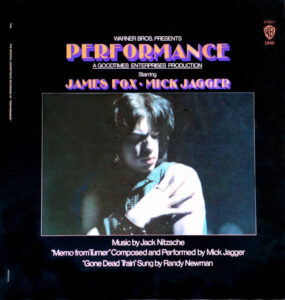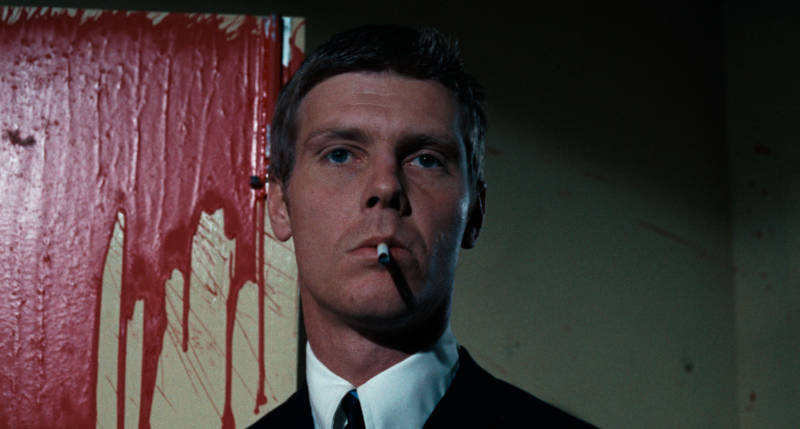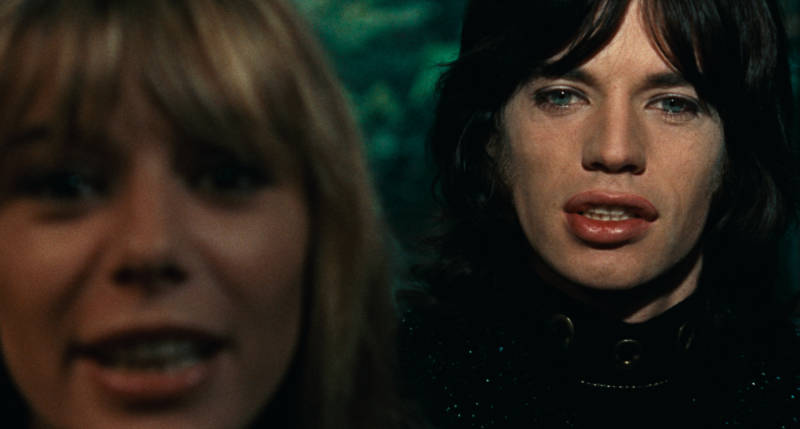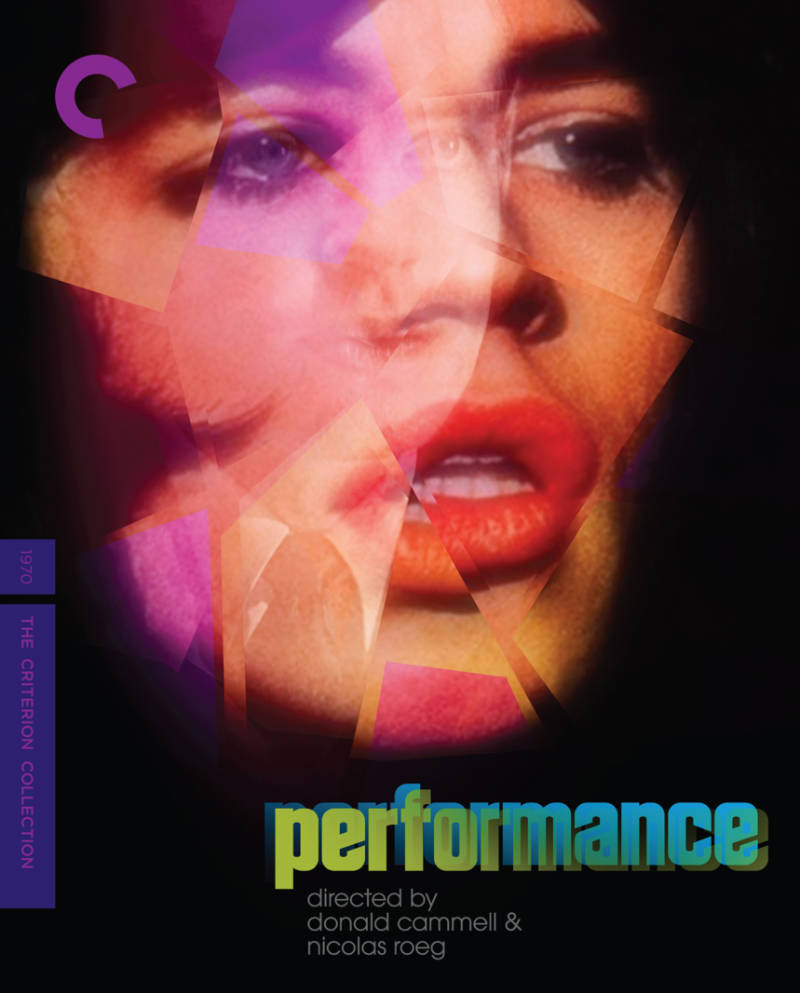By Harvey Kubernik Copyright 2025
“The world was full of 60’s light, and then came Performance…” —Andrew Loog Oldham
The grimy criminal underworld and hedonistic rock-and-roll counterculture of late-1960s London collide in this mind-scrambling, kaleidoscopic freak-out film, starring Mick Jagger in his most magnetic narrative-film performance. This 1970 British crime drama, initially theatrically released in 1970, was written by Donald Cammell, and directed by Cammell and Nicolas Roeg.
Arranger and composer Jack Nitzsche produced the original electronic musical score and soundtrack. Musicians and vocalists Randy Newman, Russ Titelman, Merry Clayton, Ry Cooder, Buffy Sainte-Marie, the Last Poets, and Bernard Krause are heard on it.

“Performance” alternative album cover Courtesy of Heather Harris
Performance was produced by Sanford Lieberson in 1968, but not seen in theaters until 1970, owing to movie studio Warner Bros. and their reluctancy as a distributor due to the explicit violence and sexual content on screen.
Sales information from The Criterion Collection describes the product that will be available for the first time restored on 4K UHD.
“Performance is now considered a bonafide cult classic that spawned countless homages and imitators in 1990s and 2000s pop culture, and now considered one of the greatest British and gangster films of all time. On the run from his vengeful boss, a ruthless gangster (JAMES FOX) hides out in the Notting Hill home of a reclusive rock star (MICK JAGGER) and his companions (ANITA PALLENBERG and MICHELE BRETON), who open the doors of his perception as the lines between reality and fantasy, male and female, persona and self, dissolve in a hallucinogenic haze. Built around Jagger’s most magnetic narrative-film performance, this visionary collaboration between enigmatic artist DONALD CAMMELL and first-time director NICOLAS ROEG is a daringly transgressive, endlessly influential journey to the dark side of bohemia. Nicolas Roeg was a highly influential British filmmaker also known for his films Walkabout, Insignificance, and Don’t Look Now. The Criterion Collection includes a new visual essay by biographer Keiron Pim; documentary about Cammell; program featuring Fox, Jagger, Pallenberg, and others; and more.”

James Fox photo Courtesy of The Criterion Collection
If you want or really need a deep-dive exploration of Performance, may I suggest a 1999 book from UK-based music journalist and author Mick Brown, Performance: The Ultimate A-Z (Bloomsbury Movie Guide). Brown is a features writer for the Daily Telegraph and the Telegraph Magazine. Brown provides an inside look into the Performance backstory. The influence of film editor Frank Mazzola is obvious. Frank did post-production re-editing working with Donald Cammel after a directive by concerned Warner Bros. studio executives. An actor, Mazzola had small roles in Casablanca, Rebel Without A Cause, East of Eden and The Hunchback Of Notre Dame.
“It wasn’t the first,” states music journalist and photographer Heather Harris. “There have been clearly bisected movies before and since the release of The Wizard of Oz wherein the first scenes seemingly bear scant resemblance to the later plot until reunited with the visuals and exposition during the last part of the film. Full Metal Jacket is one such example made in many readers’ lifetimes, plus From Dawn to Dusk and 2021’s Last Night in Soho. “But none so glaringly as cult film Performance, a work which deservedly has remained in the public eye since its 1968 inception (with delayed 1970 release) for a variety of clear reasons: superb casting of the world’s then most famous young rockstar and coaxing a memorable portrayal from him; casting said rockstar’s guitarist’s real life significant other in the leading role interacting opposite him, even in X-rated scenes; a groundbreaking soundtrack by genuine rockers (and the real, first ever rap group The Last Poets,) which soundtrack also was first to use the then brand new Moog synthesizer effectively instead of just for special FX; violence so extreme as consign Sam Peckinpah massacres to kindergarten classes; and a montage-y art film sensibility that still reads to the viewer as a linear plot. Which is hard to do.
“The plot conceit might seem to harken to 1936’s The Petrified Forest with its contrast of hard mob man versus aesthete dragooned to protect same. But check the pedigree of its filmmakers, which this flashy new re-release does, with its bio-feature of co-director Donald Cammell.

Anita Pallenberg and Mick Jagger Courtesy of The Criterion Collection
“Cammell and his brother David previously had written The Touchables a 1960s pop culture-drenched film about a rockstar kidnapped by London dollybird models (the film is WAY better than this sounds) which strikingly featured a polarity between the wispy, girly hippie world of the young women and the hyper-butch, fightclub underworld surrounding the star and his people. This film also presaged the career of Touchables co-writer Ian La Frenais who later Got Rock ’n ’Roll Right in the films Still Crazy and The Commitments.
“If Sam Peckinpah violence is not your bag in our modern world of real life horrors (which I concede is a wholly understandable stance of self-preservation,) this subjective suggestion outlines how better to enjoy the film. Watch it twice, thusly. First, of course, all the way through. We know it’s in two parts, the first gore-spattered one ending around 37 minutes into the film, when a protagonist escapes certain assassination. Then, give yourself a break. Watch the film on another day from 37 minutes into it to the end.
“Enjoy the real late 1960s London. You also can relish the uniqueness of seeing your real- life rock ‘n’ roll figures of infinite folklore interact decadently with one another in the claustrophobic confines of the location mansion. Retro buffs can have a field day checking the set design within. Best of all, there’s cool porn with the amazingly attractive Mick Jagger and Anita Pallenberg of the late 1960s. You’ll never again question what their real- life partners saw in them, no matter how remote these celebs seem.
“Everything that underscores its unique place in cinema history remains as viable today, 2025, as when I first saw one of the Performance previews at the Warner studio in 1969. It holds up. Strongly. And how.”
“Performance is a peak Stones album masquerading as a movie,” explains musician and author Kenneth Kubernik.
“It nailed the pop culture moment – late ’68, druggy, insolent, debauched – the way ‘Stray Cat Blues’ captured the prey drive of a big cat stalking its next meal. It’s ‘Monkey Man’ writ large, all of Turner’s friends no doubt junkies, reprobates, messianic tramps and thieves.
“I never ‘watch’ Performance, I surrender to it, to its drug-addled, funhouse mirror imagery of grotesqueries parading through their tawdry, salacious ambits. Anita, the sixth Stone (sorry, Ian) is the sun around which all this depravity swirls, her every mannerism, pose, pronouncement a sensual/sensorial assault. Jagger, channeling Brian’s withering excesses, Keith’s louche edginess, draw us tantalizingly within the opiated cocoon of rock aristocracy’s inner sanctum. Not surprisingly, the suits at Warner Bros. freaked; they’d never seen cinema that could bite like that.”
From 1964-1967, Jack Nitzsche was a major contributor to the Andrew Loog Oldham-produced Rolling Stones’ recording sessions in Hollywood at RCA studios on Sunset Blvd. Nitzsche’s keyboard, harpsichord and percussion work can be heard on such Stones items as “Play with Fire,” and “Yesterday’s Papers,” He played tambourine and piano on “Satisfaction,” and was the pianist on “Let’s Spend the Night Together.” Jack did the choral arrangement for the choir on “You Can’t Always Get What You Want” from the Let It Bleed album.
It was Andrew in 1964, who wanted to meet Nitzsche when he and his band landed in Hollywood during ’64.
After he discovered the Rolling Stones in 1963, Andrew produced a 1964 session with John Baldwin, (then quickly re-named John Paul Jones, before his Led Zeppelin career) on a re-make of Nitzsche’s “Baja,” written by Lee Hazelwood, the flip side of Jack’s instrumental anthem, “The Lonely Surfer.”
During a 2013 interview with record producer and artist manager Denny Bruce, who represented arranger/composer/songwriter and record producer, Jack Nitzsche, Bruce discussed 1966-1969 encounters with Marianne Faithfull, Anita Pallenberg, Brian Jones and Keith Richards.
“Being in Los Angeles in 1966, Keith and Brian wanted to know if anybody, like Lowell Fulson, was playing at any blues club in town? ‘Tramp’ by Lowell was number one this week on their turntables. Jack took the whole band to Watts to see Etta James at the California Club. I was invited to one of the Aftermath recording sessions at RCA studios.
“In fall of 1967 I heard the final mix of Neil Young’s ‘Expecting to Fly’ recording on Buffalo Springfield Again one night at Jack’s house. Keith Richards and Anita Pallenberg were there. Jack said it was ‘the perfect recording to smoke pot with.’
“Earlier that afternoon I drove Keith and Anita in my Volkswagen to Disneyland. My first Cali car. I clearly remember driving my VW bug with Keith and Anita. That was it – just the three of us. Anita got in and then Keith got in, but didn’t move the seat to get in the back. So, it was hard to drive and shift gears with Anita’s crotch on the floor mounted gear shift.
“She beamed and said, ‘This is fabulous being in a Volkswagen in Los Angeles!’
“Somewhere in the 1967, or ’68 time period Mick, Keith and Jack worked with Marianne Faithfull on ‘Sister Morphine’ during the days hanging by Jack’s swimming pool. Keith and Anita liked getting out of the hotels. Marianne and Anita liked to swim in his pool. During their visit we went out to eat several times.
“What people forget was it was hard just to get into Disneyland in those days if you had long hair. I was lucky with Keith and Anita as it was a slow day there, and he was not wearing anything unusual. But showing up as 5 people, looking like a band, would have caused trouble with security,” Bruce reminded me.
“I also saw the first test screening of Performance with Jack at a theater in Santa Monica. It wasn’t well received,” recalled Denny.
Upon initial theatrical release in 1970, the movie got mixed reviews. Charles Champlin in the August 5, 1970 edition of The Los Angeles Times called it a “pretentious and repellent little film that cannot rise above the world it pretends to examine.”
In October of 1969, Bruce and Richards went shopping for records. Denny schlepped Keith over to Ed Pearl’s Ash Grove music club on Melrose Avenue which housed a record section run by Chris Peake. Keith bought a rare copy of The Cool Sounds of Albert Collins. Denny at the time managed Collins.
I interviewed Jack Nitzsche and Andrew Loog Oldham in 2000, and Russ Titelman during 2018.
Andrew Loog Oldham: When I produced the Stones at RCA, to make them feel comfortable, I shrunk and lit the room for them. I was doing set design even then. There you are. I do dreams, not business. I think there are two tambourines on ‘Satisfaction.’ There’s a regular one is Jack Nitzsche. But in the middle, it was too American for that part and that’s Brian Jones. And Jack plays piano. He was brilliant, man. Come on. The piano on ‘Satisfaction’ and ‘Let’s Spend The Night Together’ was just turnaround Charlie. The harpsichord on ‘Play with Fire’ is Jack.
“If I were to try and define Jack’s overall contribution, I’d say he provided the melodic bond, the undercurrent to Keith and Brian’s layers of guitar brainwash. Jack was always the consummate pro. Jack gave us an understanding of tone. Which tone fits the universe? Which thing was hummable in the street?
“Jack understood microphone placement, where band members sat and instrument leakage. One other thing. Jack had a grasp of, and interest in sex. How to inject sex into the sound. That is a gift of understanding between you and your third ear.”
Jack Nitzsche: I met the Stones in 1964,” recalled Nitzsche. “Andrew Loog Oldham called me up. He and the group had just met Phil Spector in England and wanted to meet me. Brian Jones was in a three-piece suit and tie. The saw me work with Edna Wright and Merry Clayton at RCA. A little later, the Stones started working at RCA and it had a big impact on me. A whole new way of approaching records. I was used to a three-hour record date, and they were block-booking twenty-four hours a day for two weeks, and doing what they wanted.”
“It was Mick who came to me about doing the Performance soundtrack. In fact, Keith and Mick wouldn’t even talk to each other during those days. Donald Cammell was close to The Stones. He knew who I was from the beginning, and they didn’t have time to score the film. Nor did they want to. So, I went to London for some reason, and saw the film during that time. They were doing Let It Bleed. The movie blew my mind the first time I saw it. Jesus Christ. . .I saw it without music. It’s very tame without music. It doesn’t take you to that crazy place. This is the only movie I have ever done where nobody interfered. Nobody. Donald Cammell would drop by the studio once in a while. He let me do whatever I wanted. I did the soundtrack in Hollywood at Western Studios.
“When I was in London, the apartment they got me was right around the corner where Keith was living with Anita. I thought ‘Memo from Turner’ had a clever lyric. I felt Mick was going in another direction from the band. With the film music I was allowed to do musically whatever I wanted to do. No instructions from the director. Nobody telling me yes or no. I did anything I wanted to do I could do. That’s what I did. You know, made up things in the studio. It was amazing. I like both the vinyl and the CD. But I have a thing for vinyl, but I like what CD does too. Anita on the screen. God damn! You saw the film. I would want to see the film again. I want to see what’s holding that film up.
“To this day, I’ll be in a restaurant, or walking down a street, or leaving a screening on a lot somewhere, like at the Paramount studio, and someone will yell out Performance! In 1999, [director] Billy Friedkin saw me walking and across the street then yelled ‘Performance! The greatest use of music in a motion picture ever!’ That was nice. I co-wrote ‘Gone Dead Train’ with Russ Titelman which Randy Newman did on the soundtrack.
“I hear Performance in some films. . . At the time I did Performance there were no synthesizers on the market. I was disappointed in the Moog. I thought it was limited. It had to be used in a different way. It couldn’t be used as a musical instrument because there wasn’t that kind of control yet. It was a prototype. I knew [electronic music Moog synthesizer pioneers] Paul Beaver and Bernie Krause. I put all kinds of weird shit in that score. Even though I still had to play the Moog with one finger.’”
“These are the people who give you total freedom. That’s when the scores turn out best. But nobody ever knows that. British directors that are fairly hip like Tony Scott, Ridley Scott, and Adrian Lynne. Adrian and Tony, I’ve worked with them and when they come to me to do their score, they’ve got the (temp) track full of Performance and One Flew Over the Cuckoo’s Nest. The British invaders, and a lot of other people, who are all good, they are really good at what they do, but when it comes to music there’s something all in common: They all steer me towards Performance. Free reign and musical experiments of anything I want to try. Sometimes it scares people when they hear music like Performance. As far as the use of songs in Performance, I wasn’t thinking of [music] publishing. I wanted to get the best score that anyone has ever heard. And, I felt like I got it. The Last Poets . . .”
Russ Titelman: My memory of meeting Jack was at Gold Star recording studios. I went to the Rolling Stones’ ‘Satisfaction’ session at RCA. Jack was playing tambourine. Fantastic.
“I played on the soundtrack for the film Village Of The Giants that Jack scored. What Jack hired me to do was to co-write songs with him on that movie. Later, I played on Jack’s soundtrack to the movie Candy which was not used. A great soundtrack. It was me, and (Ry) Cooder. I did a lot of sessions with Jack, including Neil Young’s ‘Expecting To Fly.’
“I worked with Jack on his Performance soundtrack. It’s like a defining moment I think in movie score history what he did on that soundtrack is just so unusual and groundbreaking in a lot of ways. There hadn’t been a soundtrack like that before.
“They had the track of ‘Memo from Turner’ with Mick (Jagger) singing done in England, but Donald Cammel the director didn’t like the track. So, he said, ‘Why don’t you guys play it?’ It was 1969 and there was nothing unusual about people flying tapes over. So, we had Jagger’s voice [cut at Olympic Studios] on click and we played live to that as if he were there singing. I think we ran it once or twice and I played the ‘Keith Richards’ rhythm guitar, Ry Cooder played the slide, Randy Newman played the organ, Bobby West was the bass player. He was great. It’s a unique kind of bass part for anything having to do with the Rolling Stones. ‘Cause it’s like an R&B, ‘James Jamerson’ bass part. Gene Parsons was the drummer. [Milt Holland is on percussion].
“We ran it a couple of times and just cut it at United Studios in B. That was it. ‘Memo from Turner’ is a great thing. ‘Gone Dead Train’ we cut it live and Randy Newman sang it.
“I was there for the whole thing. We saw the screenings of Performance. And what was so fantastic about it is what Jack brought to the overall sound of that soundtrack. He had like a woodwind quintet tamboura and veena. The Last Poets were used, it was their recording. Buffy Sainte-Marie with mouth-bow solos. But then the choral stuff that he did and the use of synthesizer on it was rather advanced. The Moog and combining these scary foreboding sounds and surrounded it with rock ‘n’ roll instruments. Or added rock ‘n’ roll instruments. But there are all those cues that are kind of scary and he was a master at doing that stuff. The ‘Harry Flowers’ cue is a great cue. It’s like muzak, but it’s the coolest muzak you ever heard. In every case he did something magical. Lowell George also appeared uncredited on the Performance soundtrack before Little Feat had a record deal. I met Lowell at the Ravi Shankar Kinnara School of Music.”
“Flashing back over Fifty Light years ago, recalling a true story how the iconic ‘Memo from Turner’ scored for the late-60’s London-based film Performance, resulted in my receiving top honors from UCLA,” emailed music industry executive Pam Turbov.
“Performance single-handedly captured mysterious insights to rock ‘n roll’s ultimate inner circle. The elite lifestyle, champagne wishes and mushroom dreams. Starring the charismatic Rolling Stones front man Mick Jagger, the devilishly handsome James Fox and magical high priestess Anita Pallenberg, this emotionally charged psychedelic confessional became a handbook, or perhaps, a manifesto, to ‘performance the cult classic of midnight art film scenes.’ Decadent, hedonistic revealing counter culture’s wild hidden secrets, it was veritable smorgasbord of guilty pleasures, that were only revealed after the 20th viewing.
‘“Memo from Turner’ became a mesmerizing mantra, thus the obvious choice for my mid-1970s UCLA requisite final speech soliloquy exam. Staring into an antique Moroccan mirror, confidently projecting my best Jagger, swagger, reciting ‘Come now, gentleman, your love is all I crave/You’ll still be in the circus when I’m laughing, laughing in my grave.’
“Thinking to myself, it was quite an impressive delivery, rather than opting for the predictable classic Shakespearean Hamlet passage: ‘To be or not to be.’ Both the professor, and the entire classroom of fellow aspiring thespians were a bit shocked but sheepishly grinned at my passionate performance. Despite a careful introduction to the song, I always wondered if anyone actually had a clue to the cinematic origins of ‘Memo from Turner.’ Remarkably earning me top honors. The Performance encounter inspired portal traversing through space and time, alternative reality yet still captivatingly audiences in today’s world.
“Conscious. And subconscious Fantasy. And reality. Vice. And versa.”
(Harvey Kubernik is the author of 20 books, including 2009’s Canyon Of Dreams: The Magic And The Music Of Laurel Canyon, 2014’s Turn Up The Radio! Rock, Pop and Roll In Los Angeles 1956-1972, 2015’s Every Body Knows: Leonard Cohen, 2016’s Heart of Gold Neil Young and 2017’s 1967: A Complete Rock Music History of the Summer of Love. Sterling/Barnes and Noble in 2018 published Harvey and Kenneth Kubernik’s The Story Of The Band: From Big Pink To The Last Waltz. In 2021 the duo wrote Jimi Hendrix: Voodoo Child for Sterling/Barnes and Noble. Otherworld Cottage Industries in 2020 published Harvey’s Docs That Rock, Music That Matters. His book Screen Gems:(Pop Music Documentaries and Rock ‘n’ Roll Television Moments) is scheduled for 2025 publication. During 2006 Harvey spoke at the special hearings by The Library of Congress in Hollywood, California, discussing archiving practices and audiotape preservation. In 2017 Kubernik appeared at the Rock and Roll Hall of Fame in Cleveland, Ohio, in their Distinguished Speakers Series).

